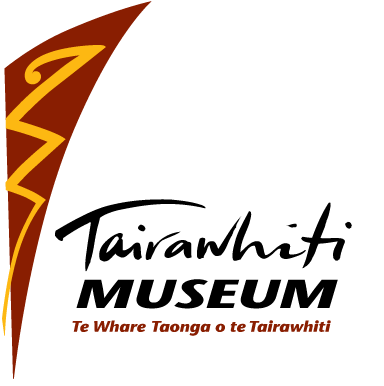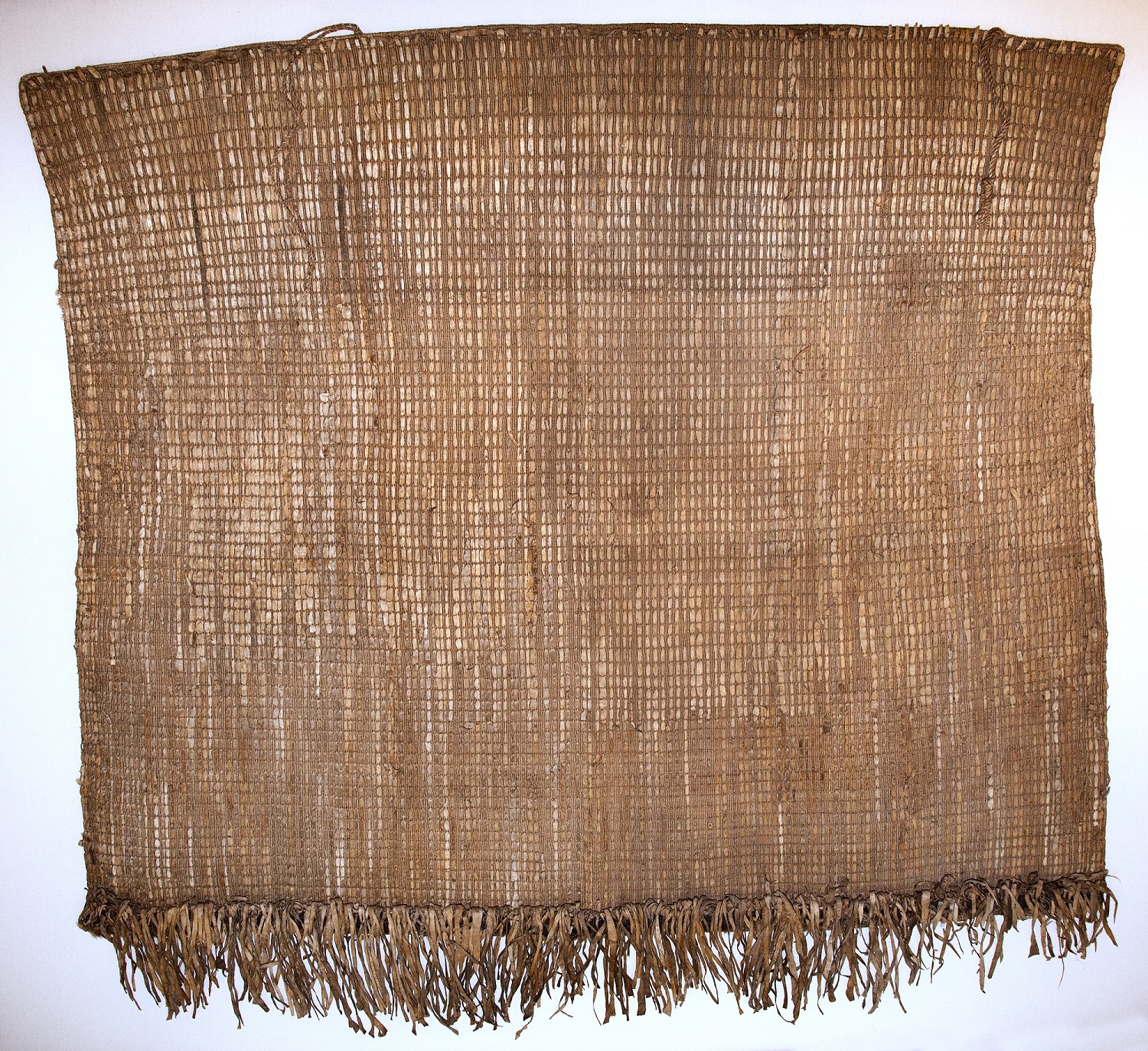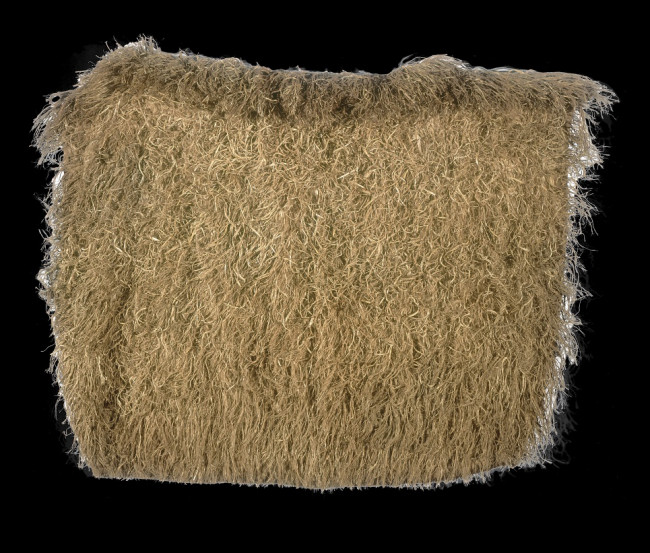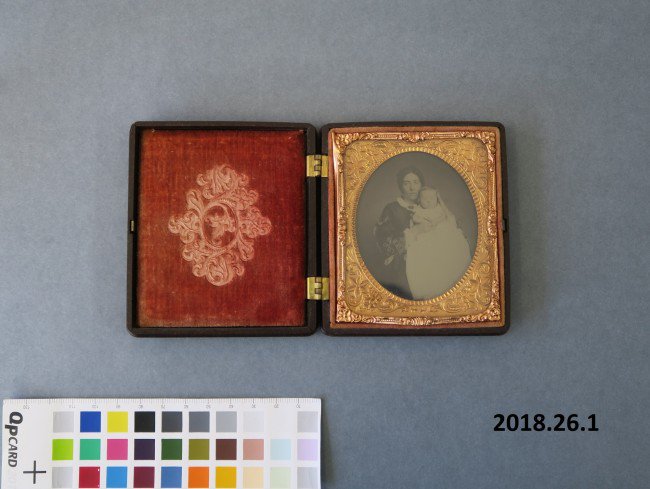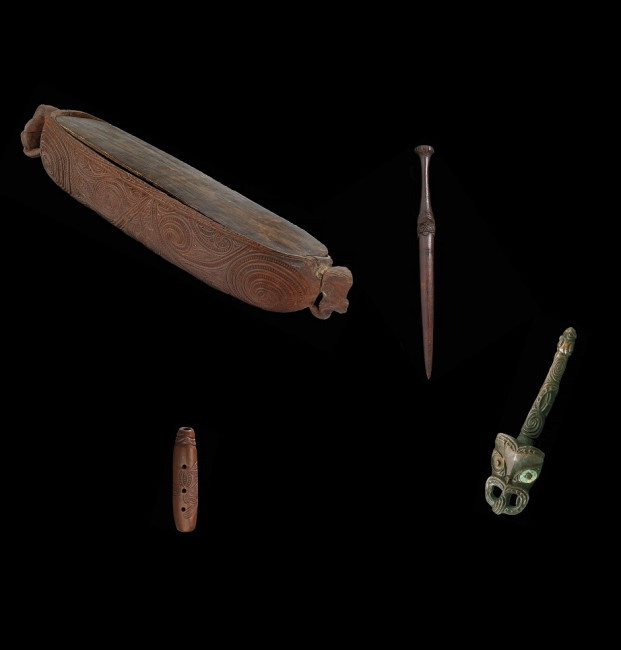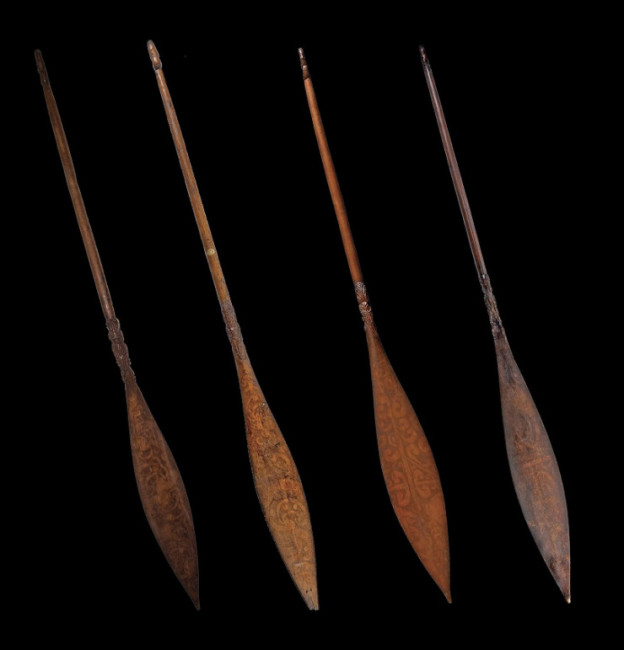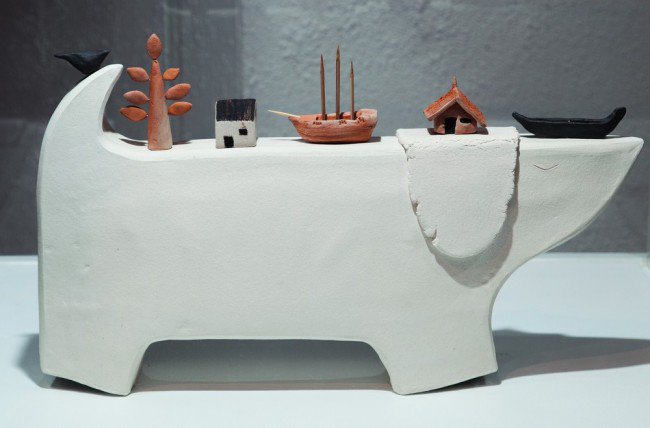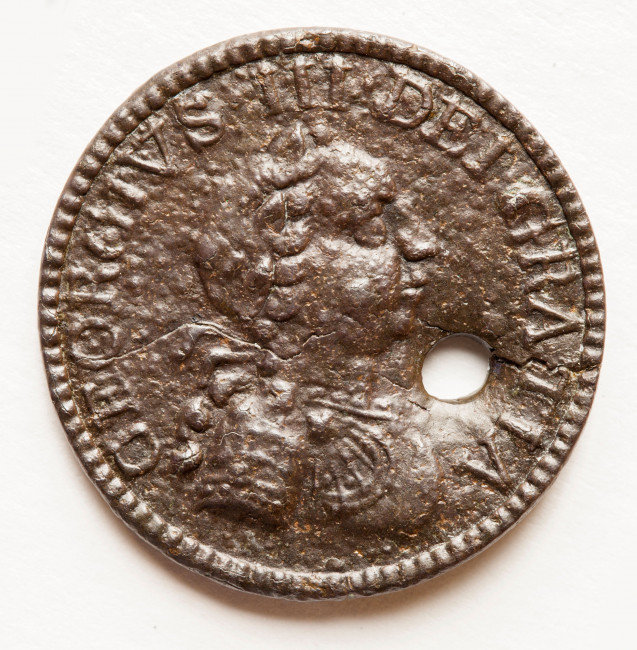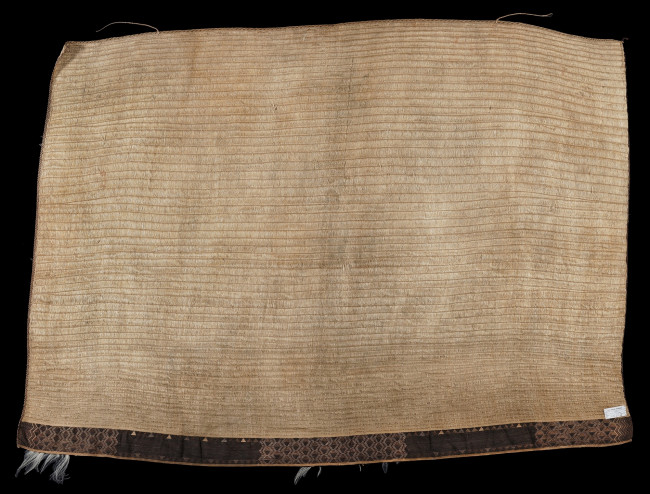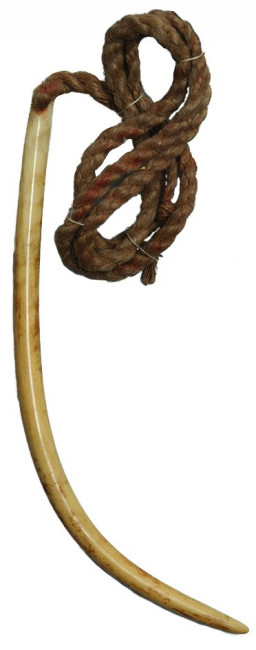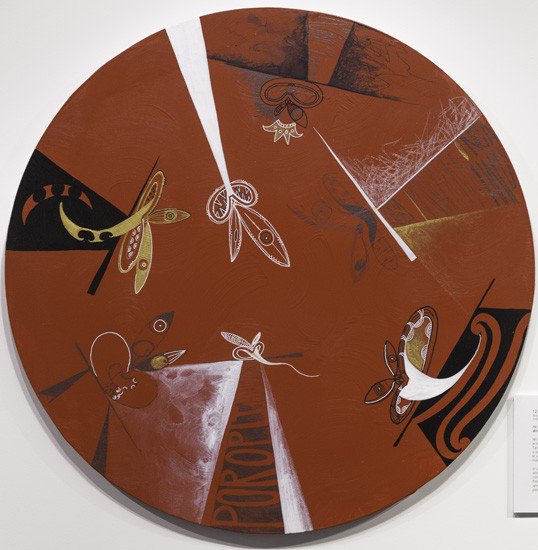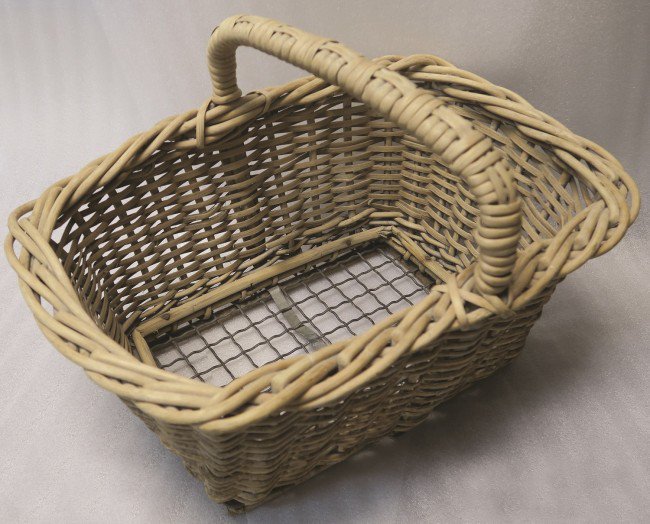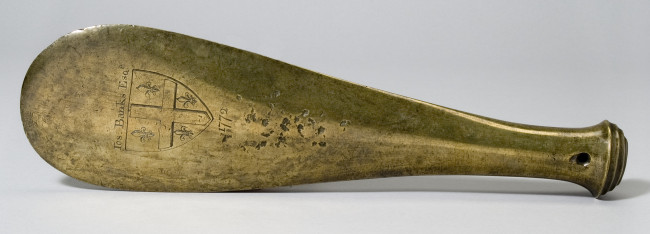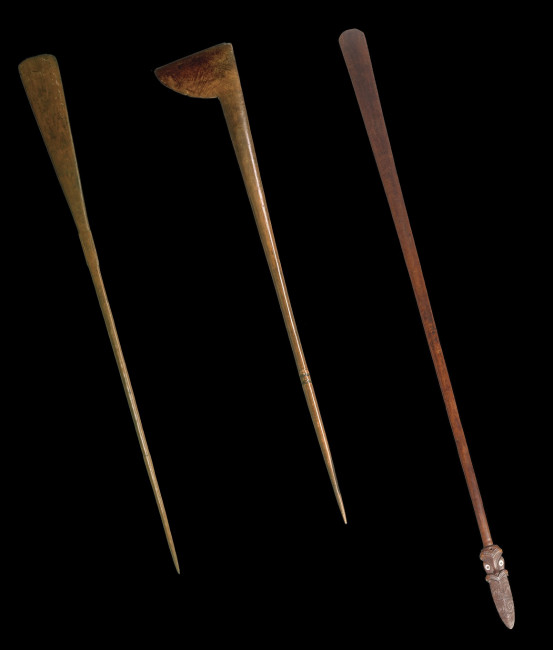Tīmata i te taha mauī
Tātua belt
Muka harakeke Flax fibre
Ngaio ake nei, me he whare pūngāwerewere te tōrire me te putuputu hoki o te mahi autaia ā te ringarehe kei tēnei hanga tātua e mau ana. Whakamaua ai tēnei momo hei tātāwhi i ngā taonga whawhai, hanga poto, pēnei i te patu. He tau tēnei tātua mā te toa pārae-roa. Me te aha, ko ngā mukunga kōkōwai te tohu e whakaū ana i tēnei huatau.
This belt is an exceptional example of traditional fine weaving. Tātua of this kind were worn around the waist to secure small weapons such as patu (short-handled clubs). This artistically constructed belt with fine closely woven muka (flax fibres) would have been worn by a warrior, as the red ochre markings or kōkōwai confirm that it was made to be worn in battle.
On loan from Cambridge Museum of Archaeology and Anthropology, D1914.48
Kahu kurī dog-skin cloak
Muka harakeke, kiri kurī
Flax fibre, dog-skin
Inā ngā momo kahu kurī, he tōpuni, he awarua, he kahu waero, he māhiti, ā, he pūahi, heoti katoa ēnei nā te rangatira. Hai tā Hirini Moko Mead he pūahi tēnei momo kahu kurī. He mea hanga ki ngā wahanga kiri kurī tuarea, he mea whiri tonu ki tōna kaupapa, nā rā, he kaupapa whatu aho-pātahi, hei kahu parepare, me uaua e ngoto ai te kiri. Kei raro iho i ngā kururemu kiri kurī he mahinga tāniko.
Kahu kurī came in many different styles, such as tōpuni, ihupuni, awarua, kahu waero, māhiti, and pūahi, but any such cloak identified its owner as a rangatira. Hirini Moko Mead defines this particular type of cloak as a pūahi. It is woven with the close single-pair twine of muka (flax fibre) which form a thick impenetrable covering. Strips of dog skin were attached to the kaupapa (body of cloak) during the weaving process. There is also a plain tāniko band under the dog skin fringes.
On loan from British Museum Oc NZ 125
Tū te Whaihanga Showcase 4
Pākē rain cape
Ambrotype, possibly of Lucy and her daughter Ida Tiffen
The museum is offered many interesting items for the collection over the course of the year. Often they are seemingly ordinary, everyday objects, but what makes each of them special and worthy of collecting is the wonderful stories they can tell us about our region’s history. This wicker basket is certainly one such object. This basket was used by William Hamilton (known as Ham) Hannah (b. 1920, d.1967) to deliver bread for Walter Findlay’s Bakery in the 1930s. Ham would have delivered bread around Gisborne by horse and cart. A few people out there may remember having bread delivered by him, perhaps using this basket! Ham served as a Driver in the Army Service Corps in the Second World War and continued to work as a driver when he returned to Gisborne after the war. In the 1960s, he was the Custodian at Churchill Park. He was married to Sarah (Sadie) and they had four children. We would like to thank Julie Hannah for gifting her father-in-law’s breadbasket to the museum.
Ham and two of his four children, Kevin (left) and Gareth (right), posing in the basket in the garden of the family’s home.
Walter Findlay’s advert, The Gisborne Herald, 20 October 1941
Tū te Whaihanga Showcase 11
Kōauau flute Paepae hamuti latrine Turuturu weaving peg Waka huia treasure box
Tū te Whaihanga Showcase 5 and 7
Hoe paddles
Weight on the back of Te Kuri a Paoa by Peggy Ericson
The museum is offered many interesting items for the collection over the course of the year. Often they are seemingly ordinary, everyday objects, but what makes each of them special and worthy of collecting is the wonderful stories they can tell us about our region’s history. This wicker basket is certainly one such object. This basket was used by William Hamilton (known as Ham) Hannah (b. 1920, d.1967) to deliver bread for Walter Findlay’s Bakery in the 1930s. Ham would have delivered bread around Gisborne by horse and cart. A few people out there may remember having bread delivered by him, perhaps using this basket! Ham served as a Driver in the Army Service Corps in the Second World War and continued to work as a driver when he returned to Gisborne after the war. In the 1960s, he was the Custodian at Churchill Park. He was married to Sarah (Sadie) and they had four children. We would like to thank Julie Hannah for gifting her father-in-law’s breadbasket to the museum.
Ham and two of his four children, Kevin (left) and Gareth (right), posing in the basket in the garden of the family’s home.
Walter Findlay’s advert, The Gisborne Herald, 20 October 1941
Tū te Whaihanga Showcase 8
Mētara Koroneihana a Hōri III George III Coronation medalet
Tū te Whaihanga Showcase 6
Kaitaka cloak
Aurei
Aurei cloak pin Rei-puta, muka harakeke Whalebone-tooth, flax fibre
Hamuera by Erena Koopu
Hamuera by Erena Koopu, 2018 Acrylic and graphite on canvas, 710mm diameter This work by Erena Koopu was part of the exhibition Hei ō Mō Apanui | Iwi Sustenance held at Tairāwhiti Museum in 2018 and purchased by the Friends of Tairāwhiti Museum for the collection. He waiata a ringa (an action song) Performed by Te Kapa Haka o Te Whānau a Apanui at Te Matatini in the year 2005 in Palmerston North. Nō te tau 2004 ka whakaturehia e te kāwanatanga te pire takutai moana, e riro ai te taitara o te papa moana, tōna ritenga, he muru whenua. I taua tau rā, ko Tāriana Tūria te wahine toa o Reipa kāore i tautokona taua pire, ā, ko ētahi atu o ana hoa mema Māori, i tautoko tonu. He waiata-ā-ringa tēnei e kōrero ana ki aua mema rā, kia aro ki ngā tohutohu a ngā poropiti Māori, kei reira te māramatanga e noho ana. In 2004 the Government passed the controversial Foreshore and Seabed Bill, which transferred title to the crown, and in itself is a form of modern day confiscation. In that same year, Tāriana Tūria, Māori MP of Labour crossed the floor, while the rest of her Māori colleagues remained seated. This action song speaks to those seated members, and urges them to remember the lessons of past Māori prophets, as clarity must resides in their messages.
Ham Hannah’s Breadbasket
The museum is offered many interesting items for the collection over the course of the year. Often they are seemingly ordinary, everyday objects, but what makes each of them special and worthy of collecting is the wonderful stories they can tell us about our region’s history. This wicker basket is certainly one such object. This basket was used by William Hamilton (known as Ham) Hannah (b. 1920, d.1967) to deliver bread for Walter Findlay’s Bakery in the 1930s. Ham would have delivered bread around Gisborne by horse and cart. A few people out there may remember having bread delivered by him, perhaps using this basket! Ham served as a Driver in the Army Service Corps in the Second World War and continued to work as a driver when he returned to Gisborne after the war. In the 1960s, he was the Custodian at Churchill Park. He was married to Sarah (Sadie) and they had four children. We would like to thank Julie Hannah for gifting her father-in-law’s breadbasket to the museum.
Ham and two of his four children, Kevin (left) and Gareth (right), posing in the basket in the garden of the family’s home.
Walter Findlay’s advert, The Gisborne Herald, 20 October 1941
Tū te Whaihanga Showcase 13
Patu Parāhe Brass patu
Tū te Whaihanga Showcase 1
Pouwhenua weapon Tewhatewha weapon Taiaha weapon
The museum’s collections are always growing and on this page we share some of the highlights. Our thanks to the donors for their support.
Donating to the collection
Visit our Donations page for more information.
Research and access
Researchers can view collections that are not on display by making an appointment with the Museum Collection Manager. Staff can also take small group tours through the collection storage facilities by appointment. Please note that staff are not always available immediately and it is advisable to make arrangements as far in advance as possible, particularly if you are only visiting Gisborne for a short period.
Researchers who are unable to visit in person can make their enquiry by email, letter or telephone
